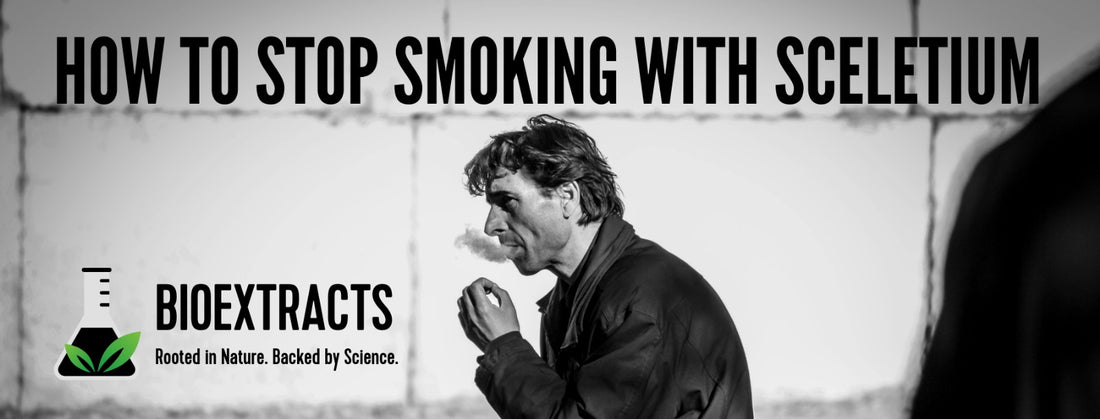
How to stop smoking with Sceletium
Share
To grasp the potential of Sceletium in aiding smoking cessation, it’s essential to first understand the mechanics of nicotine addiction and its profound effects on key neurotransmitters like dopamine. Nicotine, by interacting with acetylcholine receptors—also known as nicotine receptors—elevates the release of dopamine, serotonin, and epinephrine, leading to improved mood, reduced anxiety, and enhanced cognition. However, the euphoria is short-lived due to nicotine’s brief half-life. Continuous stimulation of acetylcholine receptors by nicotine gradually reduces their sensitivity, resulting in diminished levels of these vital neurotransmitters. This adaptation fosters a dependence on nicotine to maintain normal neurotransmitter levels, marking the onset of addiction (Benowitz, 2010).
Sceletium, or Kanna, is a succulent from South Africa, long valued by indigenous populations for its mood-enhancing properties. Recently, it has attracted attention for its potential in supporting individuals through the process of quitting smoking and managing withdrawal symptoms.
A significant hurdle in quitting smoking is the management of withdrawal symptoms such as anxiety, depression, irritability, and cravings, which stem from the reduced levels of essential neurotransmitters like dopamine, serotonin, and epinephrine (Benowitz, 2010).
Sceletium steps into this arena with remarkable properties. It possesses the capability to enhance serotonin, dopamine, epinephrine, and acetylcholine levels through the activation of specific receptors, as highlighted below.
Serotonin Transporter (SERT):
Alkaloids in Sceletium, particularly mesembrine-type, are proven to bind to serotonin transporters, reducing serotonin reabsorption and thus increasing its availability (Terburg et al., 2013).
Vesicular Monoamine Transporter (VMAT):
Mesembrine, the most prominent alkaloid in Sceletium, activates the VMAT (Coetzee, López, and Smith, 2016), which is crucial for the transport of serotonin, dopamine, and epinephrine from neuron cytosol to presynaptic vesicles, making them readily available for neuronal firing. This increase in neurotransmitter availability can significantly ease nicotine withdrawal symptoms.
Acetylcholine Receptor Sensitivity:
Nicotine’s binding and activation of acetylcholine receptors decrease their sensitivity over time, leading to dependence. Sceletium alkaloids counteract this by inhibiting acetylcholinesterase, an enzyme responsible for acetylcholine breakdown, thus enhancing its availability (Luo et al., 2022). As acetylcholine naturally activates these receptors, its increased presence can alleviate withdrawal symptoms and facilitate the restoration of receptor sensitivity, speeding up the recovery from withdrawal.
Neuroplasticity:
Reductions in serotonin and prolonged high cortisol levels are known to decrease neuroplasticity, affecting mood and making habit change difficult. This can lead to a psychological craving for smoking long after overcoming physical addiction, increasing the risk of relapse. Sceletium, by boosting serotonin and reducing cortisol levels, enhances neuroplasticity, thus supporting psychological recovery and making habit transformation more achievable (Wall, n.d.).
In summary, Sceletium, through its active alkaloids like mesembrine, offers a comprehensive approach in supporting smoking cessation. It not only helps in managing physical withdrawal symptoms by enhancing the availability of crucial neurotransmitters but also plays a significant role in psychological recovery by improving neuroplasticity and reducing cortisol levels. Consequently, Sceletium emerges as a promising natural adjunct in the journey towards quitting smoking, addressing both the physical cravings and psychological challenges of cessation
References
Benowitz, N.L. (2010). Nicotine Addiction. New England Journal of Medicine, [online] 362(24), pp.2295–2303. doi:https://doi.org/10.1056/nejmra0809890.
Benowitz, N.L. (2010). Pharmacology of Nicotine: Addiction, Smoking-Induced Disease, and Therapeutics. Annual Review of Pharmacology and Toxicology, [online] 49(1), pp.57–71. doi:https://doi.org/10.1146/annurev.pharmtox.48.113006.094742.
Coetzee, D.D., López, V. and Smith, C. (2016). High-mesembrine Sceletium extract (TrimesemineTM) is a monoamine releasing agent, rather than only a selective serotonin reuptake inhibitor. Journal of Ethnopharmacology, 177, pp.111–116. doi:https://doi.org/10.1016/j.jep.2015.11.034.
Rădulescu, I., Drăgoi, A., Trifu, S. and Cristea, M. (2021). Neuroplasticity and depression: Rewiring the brain’s networks through pharmacological therapy (Review). Experimental and Therapeutic Medicine, [online] 22(4). doi:https://doi.org/10.3892/etm.2021.10565.
Terburg, D., Syal, S., Rosenberger, L.A., Heany, S., Phillips, N., Gericke, N., Stein, D.J. and van Honk, J. (2013). Acute Effects of Sceletium tortuosum (Zembrin), a Dual 5-HT Reuptake and PDE4 Inhibitor, in the Human Amygdala and its Connection to the Hypothalamus. Neuropsychopharmacology, 38(13), pp.2708–2716. doi:https://doi.org/10.1038/npp.2013.183.
Tiwari, R.K., Sharma, V., Pandey, R.K. and Shukla, S.S. (2020). Nicotine Addiction: Neurobiology and Mechanism. Journal of Pharmacopuncture, [online] 23(1), pp.1–7. doi:https://doi.org/10.3831/KPI.2020.23.001.
Wimalasena, K. (2010). Vesicular monoamine transporters: Structure-function, pharmacology, and medicinal chemistry. Medicinal Research Reviews, 31(4), pp.483–519. doi:https://doi.org/10.1002/med.20187.
Wall, S. (n.d.). What is Brain Plasticity? | Neuroplasticity and Addiction Recovery. [online] Cumberland Heights. Available at: https://www.cumberlandheights.org/blogs/neuroplasticity-for-recovery/.
